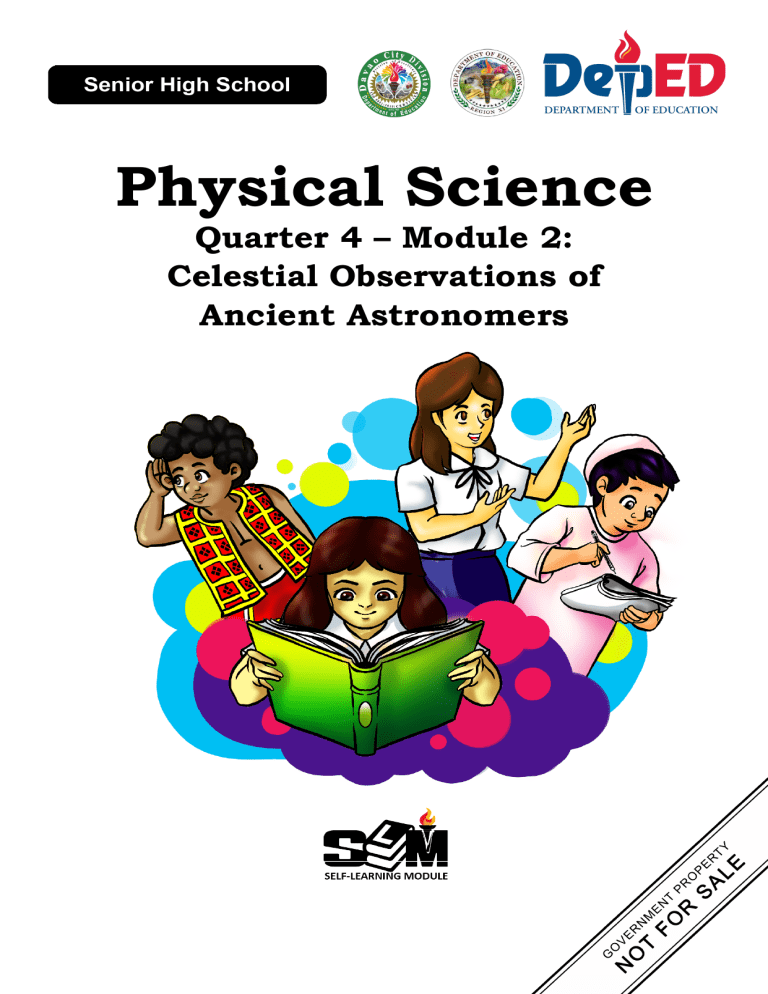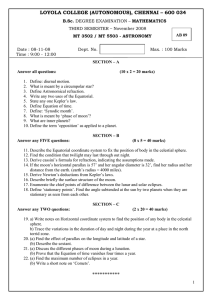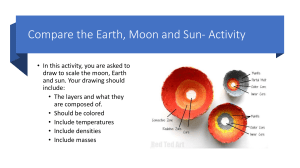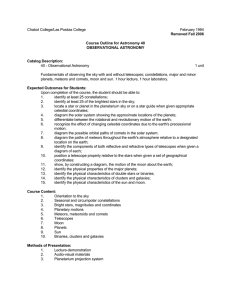
Physical Science Quarter 4 – Module 2: Celestial Observations of Ancient Astronomers Physical Science – Grade 11/12 Quarter 4 – Module 2: Celestial Observations of Ancient Astronomers First Edition, 2021 Republic Act 8293, section 176 states that: No copyright shall subsist in any work of the Government of the Philippines. However, prior approval of the government agency or office wherein the work is created shall be necessary for exploitation of such work for profit. Such agency or office may, among other things, impose as a condition the payment of royalties. Borrowed materials (i.e., songs, stories, poems, pictures, photos, brand names, trademarks, etc.) included in this module are owned by their respective copyright holders. Every effort has been exerted to locate and seek permission to use these materials from their respective copyright owners. The publisher and authors do not represent nor claim ownership over them. Published by the Department of Education – Region XI Development Team of the Module Writer: Regie P. Rodrigo Editor: Dinah G. Oani Reviewer: Genevaive M. Pepito Illustrator: Kent Francis Layaguin Layout Artist: Wedzmer B. Munjilul Template Developer: Neil Edward D. Diaz Management Team: Reynaldo M. Guillena Jinky B. Firman Marilyn V. Deduyo Alma C. Cifra Aris B. Juanillo Faye Genevieve P. Pasamonte Printed in the Philippines by ________________________ Department of Education – Division of Davao City Office Address: Telephone: E-mail Address: E. Quirino Avenue, Davao City (082) 227 4762 lrms.davaocity@deped.gov.ph Physical Science Quarter 4 – Module 2: Celestial Observations of Ancient Astronomers Introductory Message For the facilitator: As a facilitator, you are expected to orient the learners on how to use this module. You also need to keep track of the learners' progress while allowing them to manage their own learning at home. Furthermore, you are expected to encourage and assist the learners as they do the tasks included in the module. For the learner: As a learner, you must learn to become responsible of your own learning. Take time to read, understand, and perform the different activities in the module. As you go through the different activities of this module be reminded of the following: 1. Use the module with care. Do not put unnecessary mark/s on any part of the module. Use a separate sheet of paper in answering the exercises. 2. Don’t forget to answer Let Us Try before moving on to the other activities. 3. Read the instructions carefully before doing each task. 4. Observe honesty and integrity in doing the tasks and checking your answers. 5. Finish the task at hand before proceeding to the next. 6. Return this module to your teacher/facilitator once you are done. If you encounter any difficulty in answering the tasks in this module, do not hesitate to consult your teacher or facilitator. Always bear in mind that you are not alone. We hope that through this material, you will experience meaningful learning and gain deep understanding of the relevant competencies. You can do it! ii Let Us Learn A wonderful day to you little scientist! In this module, you will learn the concept of Celestial Observations of Ancient Astronomers. Specifically, you are expected to: Cite examples of astronomical phenomena known to astronomers before the advent of telescope. Let Us Try! Instruction: Choose the letter of the correct answer. Write the chosen letter on a separate sheet of paper 1. How did ancient people make use of their observations in the sky? A. They used it to plan for war and conquer new lands. B. They used it to entertain themselves during the night. C. They used it to predict their future and make stories of heroes. D. They used it for telling time, navigation, agriculture and religious practices. 2. What would you expect to see if the moon passes directly between Earth and the Sun? A. Solar eclipse B. Lunar eclipse C. Phases of the Moon D. Motion of planets 3. Constellations are patterns of stars in the night sky that change from season to season. Which constellation does NOT belong to the group? A. Leo B. Virgo C. Aries D. Orion 4. Which astronomical phenomena was used to mark the onset of seasons? A. Motion of planets B. Appearance of comets C. Occurrence of eclipses D. Changing positions of the constellations 7 5. What kind of motion is exhibited by planets that puzzled ancient astronomers for centuries? A. eastward motion B. retrograde motion C. fixed motion D. seasonal motion Let Us Study Have you ever tried looking up into the night sky away from the city lights? What did you see? You definitely saw thousands of twinkling stars and the bright Moon, right? Ancient people had much darker skies and were much more familiar with the events of heavenly bodies than we are. Do you know that ancient people were so attentive to many astronomical events in the sky? Yes, they were so serious about studying the sky for very important reasons. Early astronomers of ancient civilizations had very important and practical reasons for studying the sky. They relied so much on the different astronomical phenomena they observed in the sky to guide them in their daily lives. Before the invention of the telescope, ancient people regarded the sky as a big clock, a map, and a calendar for ancient astronomers. Some stars (such as the North Star or Polaris) served as a navigational guide. Others served as primitive calendars to predict planting and harvesting seasons and celebrating their religious feasts. In a real sense, human survival depended on knowledge of the heavens. That’s why it is not surprising to see ancient structures built for the observation of astronomical phenomena throughout the world. Moreover, the ability to predict and explain different astronomical events was highly prized. Many astronomical events have been observed since the beginning of early civilizations. These events were diligently recorded which allowed ancient people to understand them by creating ancient calendars and charts. Ancient people also attributed these astronomical events to stories of heroism, myths, and gods in order to understand them and connect with nature. So, what are those examples of astronomical phenomena they knew by observing the sky even without a telescope? Well, these are the things we will learn in this module. The following are examples of astronomical phenomena known to early astronomers even before the advent of the telescope. 8 Phases of the Moon (Lunar Phases) Ancient astronomers had observed the phases of the moon for many centuries. It takes 29.5 days for the Moon to go through its entire phase cycle. Although half of the Moon is always being illuminated by the Sun, a person on Earth will see the Moon changing its phases. These phases are the results of the various angles people see the Moon being illuminated by the Sun as it orbits the Earth. The picture below shows how the Moon undergoes different phases as seen on Earth. The Phases of the Moon The eight major phases of the Moon are, in order, (1) new Moon, (2) waxing crescent, (3) first quarter, (4) waxing gibbous, (5) full Moon, (6) waning gibbous, (7) third quarter, and (8) waning crescent. It must be remembered that the Moon doesn’t shine but it reflects light from the Sun. When we see the completely illuminated side of the Moon, the phase is full Moon (number 5 on the picture). If we can see half the sides of the Moon are illuminated, the phases are called the first and third quarters (numbers 3 and 7). If the illuminated side of Moon seems to be getting larger, the Moon is waxing, like in numbers 2 and 4. When it appears to be getting smaller, the moon is waning, like in numbers 6 and 8. Furthermore, we can see a crescent if less than half of the illuminated portion of the Moon is visible. It’s called a gibbous when more than half of the illuminated portion of it is visible. 9 The changing phases of the Moon is an important foundation of how ancient people pursued to understand the heavens. They used the position of the moon relative to the stars to determine the month, and the lunar phases to determine the day in the month. Ancient people also used the lunar phases to guide their planting seasons and determine the perfect time for their religious ceremonies. Interestingly, the word month is derived from the word Moon. The phases of the moon are the basis of creating ancient calendars. Occurrence of Eclipses Ancient astronomers also recorded the appearance of eclipses. An eclipse happens when one celestial body like a moon or planet passes into the shadow of another celestial body. Eclipses do not occur frequently because they need specific alignment of the Sun, Moon, and Earth. The two types of eclipses that we can observe on Earth are the lunar and solar eclipses. A solar eclipse happens when the Moon passes between the Earth and the Sun. However, a lunar eclipse happens when the Earth passes between the Moon and the Sun. Both eclipses cause one heavenly body to partially or totally cover the Sun. Interesting discoveries in ancient astronomy were possible by studying eclipses. One example was when Aristotle observed that the Earth’s shadow 10 had a circular shape as it moves across the moon. He suggested that this must mean the Earth was round. Another Greek astronomer named Aristarchus was able to estimate the distance of the Moon and Sun from Earth by observing a lunar eclipse. In contrast, eclipses had negative interpretations for ancient people. In ancient Greece, a solar eclipse was seen as a sign that the gods were angry and was thought to be an omen of bad things to come. For the Assyrians and Babylonians, lunar eclipses were regarded as evil omens directed against their kings. In ancient China, eclipses were seen as divine messages that foretell the future of the Emperor. This made predicting eclipses to be of high importance for them. Motion of Planets Aside from the Sun, Moon, and stars, ancient astronomers noticed five objects appearing to be points of light that move relative to the other stars. The Greeks gave this type of objects the name “planetes", meaning "wanderers”. However, these planets were named after the Roman gods. Mercury, Venus, Mars, Jupiter, and Saturn are the planets that have been known and observed since prehistoric times. The eastward motion of the planets against the background of fixed stars was observed by ancient astronomers. As the planets move across the sky, they would brighten and dim at different points in their motion. The 11 problem in the observed behavior of planets was that of retrograde motion which puzzled ancient astronomers for centuries. This is where a planet seemed to move backwards on its path across the sky through the constellations before returning to its normal direction. Nevertheless, this was resolved by Nicolaus Copernicus after he proposed the heliocentric model which placed the Sun at the center of the solar system instead of the Earth. It must be noted that planets closer to the Sun revolve faster than the others further away. Thus, the retrograde motion of a planet is an illusion that an observer sees when Earth and a planet like Mars having different speeds overtake each other while orbiting the Sun. The picture below shows the retrograde motion of Mars. The Retrograde Motions of Mars Usually, the planets move along or near the ecliptic. The ecliptic is an imaginary line in the sky that marks the annual path of the sun. This word is derived from the fact that it marks the line along which eclipses occur. The Moon as well as the zodiac constellations also move along or near this path. To the naked eye, each of the five planets looks like a bright star. Venus is the brightest planet and even brighter than the stars in the night sky. Ancient people thought that the Sun and Moon are also planets but this is not true in our modern astronomy. However, the days of the week were named after the Sun, the Moon, and the five visible planets. 12 Changing Positions of the Constellations Early astronomers from different civilizations found their own patterns of stars in the night sky that change from season to season. These groupings of stars are called constellations. Many constellations are well-known to be visible in the night sky such as Orion, Ursa Major, Cassiopeia, and Cygnus. However, the most familiar are those that comprise the star signs of the zodiac: Aries, Taurus, Gemini, Cancer, Leo, Virgo, Libra, Scorpius, Sagittarius, Capricornus, Aquarius, and Pisces. They are also seen along the ecliptic. Currently, modern astronomers officially recognize 88 constellations covering the entire sky in the northern and southern hemispheres. The Earth’s revolution around the Sun is causing the changes in the positions of constellations over time. As the Earth revolves around the Sun, different sets of stars appear at different points in the Earth's orbit. This means that if we view a group of stars this month, they will appear in a different position and another group of stars will start to appear in the night sky the following month. The picture below shows how the twelve constellations of the zodiac change month after month. The Twelve Constellations of the Zodiac Historically, the twelve constellations of the zodiac have acquired special significance for thousands of years. Their changing positions and 13 appearance throughout the year marked the onset of seasons. This allowed the ancient people to create various calendars for them to know when to plant crops and harvest them. Certain constellations were also utilized to help seafarers travel across oceans. An example of this is the Ursa Major where you can spot the Northern Star (Polaris). The height of the Northern Star can determine your latitude and it will always lead you to a northward direction. Appearance of Comets Ancient civilizations also recorded the spectacular appearance of comets. Comets are smaller celestial bodies that also revolve around the Sun. They are thought to be leftovers after the formation of our solar system which happened 4.6 billion years ago. A comet is mainly composed of rock, dust, and frozen gas. When comets make their way closer to the Sun, they eventually form tails of dust and ionized gas. A Comet Appears in the Night Sky over a Mountain A brilliant comet can be seen from Earth without using a telescope. As comets move across the fixed background of stars, they first appear as bright, glowing objects, and they appear to grow larger over time to reveal luminous tails that can extend more before the comet eventually fades and disappears. The appearance of a comet in the sky had negative interpretations to the ancient people. Until the sixteenth century, comets were regarded as bad omens of the deaths of kings or noblemen, incoming catastrophes, and possible attacks of heavenly beings against humans. 14 Let Us Practice Activity 1.1: Matching Type Instruction: Match column A with the correct statements on column B regarding the examples of astronomical phenomena known to early astronomers before the advent of the telescope. Write only the letter of the correct answer on a separate sheet of paper. COLUMN A COLUMN B 1. Phases of the Moon A. This explains the movement of five visible starlike objects moving eastwards along the ecliptic relative from the background stars and exhibiting retrograde motion. 2. Occurrence of Eclipses B. This represents the different shapes of the Moon's portion illuminated by the Sun as viewed from Earth. 3. Motion of Planets C. It happens when different groups of stars can be viewed in the night sky as the Earth revolves around the Sun. 4. Changing Positions of Constellations D. This happens when an icy celestial object moves closer to the Sun revealing a luminous tail of dust and gases. 5. Appearance of Comets E. It happens when a celestial body partially or totally covers another celestial object. Were you able to do it? I hope you find it easy. In the next activities, you will still use what you have learned to accomplish them. Let’s continue our learning journey in this module. 15 Let Us Practice More Activity 1.2: Scrambled Words Instruction: For this activity, study the scrambled letters and try to unscramble or rearrange the letters to form a word or phrase that fits the given clues. Write your answers on a separate sheet of paper. 1. 2. 3. 4. 5. 6. 7. 8. 9. 10. 1. 2. 3. 4. 5. 6. 7. 8. 9. 10. EANDRSEWR IELONCSTLONSTA ECTNRSEC ETOCM AOSLR PELSECI EIAOSACPIS EAHSPS FO HTE OMNO TIASRSGTIUA CI EPCTIL TIUPRJE _________________________________ _________________________________ _________________________________ _________________________________ _________________________________ _________________________________ _________________________________ _________________________________ _________________________________ _________________________________ The English translation of the Greek word “planetes”. The different groups of stars forming patterns in the night sky. The appearance of the moon when less than half of its visible part is lit. The appearance of this celestial object is considered a bad omen of the death of kings or noblemen by ancient people. This happens when the Earth is between the Moon and the Sun and the Moon partially or totally blocks out the Sun. One of the well-known constellations. The different ways the Moon looks from Earth over a month. One of the twelve constellations of the zodiac. The imaginary line on the sky that marks the annual path of the sun. One of the five planets visible to the naked eye. 16 Let Us Remember The study of the heavens especially certain astronomical phenomena was very essential to the survival of the ancient people. They used it for timekeeping, navigation, agriculture, and religious practices. The examples of astronomical phenomena that were known to early astronomers even before the invention of the telescope are the following: 1. The phases of the Moon or lunar phases represent the different shapes of the Moon's portion illuminated by the Sun as viewed from Earth. The phases of the moon are the basis of creating ancient calendars. 2. The occurrence of eclipses happens when a celestial body partially or totally covers another celestial object. The Sun, Moon, and Earth must be on a specific alignment for this to occur. Ancient scientific discoveries were possible by observing eclipses. However, eclipses were regarded as signs that gods were angry and were thought to be an omen of bad things to come. 3. The motion of planets explains the movement of the five bright starlike objects visible in the sky that are moving eastwards along or near the ecliptic relative to the background stars. The planets were also observed to exhibit retrograde motion. The days of the week were named after the Sun, the Moon, and the five visible planets (Mercury, Mars, Venus, Jupiter, Saturn). 4. The changing positions of the constellations is a phenomenon by which different groups of stars can be viewed in the night sky as the Earth revolves around the Sun. Their changing positions and appearance every year marked the onset of seasons and even helped seafarers travel across oceans. 5. The appearance of comets happens when an icy celestial object moves closer to the Sun revealing a luminous tail of dust and gases. This is a natural celestial phenomenon however comets were usually considered bad omens of the deaths of kings or noblemen, incoming catastrophes, and possible attacks of heavenly beings against humans. 17 Let Us Assess Instruction. Choose the letter of the correct answer. Write the chosen letter on a separate sheet of paper 1. What causes the change of constellations in the sky? A. This is due to the rotation of Earth on its axis. B. This is due to the motion of stars in the universe. C. This is due to the motion of the Earth in its orbit around the Sun. D. This is due to the motion of the Sun along the line of the ecliptic. 2. How did ancient people make use of their observations in the sky? A. They used it to plan for war and conquer new lands. B. They used it to entertain themselves during the night. C. They used it to predict their future and make stories of heroes. D. They used it for telling time, navigation, agriculture, and religious practices. 3. Which of the following planets cannot be seen through the naked eye? A. Venus C. Neptune B. Jupiter D. Mercury 4. What would you expect to see if the Moon passes directly between the Sun and Earth? A. Solar eclipse C. Phases of the Moon B. Lunar eclipse D. Motion of planets 5. How many days does the Moon complete its phases? A. 26.5 days C. 28.5 days B. 27.5 days D. 29.5 days 6. Which constellation does NOT belong to the group? A. Leo C. Aries B. Virgo D. Orion 7. Which astronomical phenomena was used as the basis of creating ancient calendars? A. Phases of the Moon B. Occurrence of comets C. Appearance of eclipses D. Changing positions of the constellations 18 8. Which astronomical phenomena was used to mark the onset of seasons? A. Motion of planets C. Occurrence of eclipses Changing positions of the B. Appearance of comets D. constellations 9. What would you expect to see when the Earth passes directly between the Sun and the Moon? A. Solar eclipse C. Phases of the Moon B. Lunar eclipse D. Motion of planets 10. Which astronomical phenomena is considered to foretell the future of the Emperor in ancient China? A. Motion of planets C. Occurrence of eclipses B. Phases of the Moon D. Appearance of comets 11. Which astronomical phenomena signifies incoming catastrophes for ancient people? A. Motion of planets C. Occurrence of eclipses B. Appearance of comets D. Phases of the Moon 12. What celestial bodies are moving along or near the ecliptic aside from the five visible planets? A. Sun, Moon, and Earth B. Sun, Moon, and comets C. Sun, Moon, and meteors D. Sun, Moon, and zodiac constellations 13. What is the direction of the motion of planets along the ecliptic against the background of fixed stars? A. northward C. eastward B. southward D. westward 14. Which planet is the brightest among the others that can be seen in the night sky? A. Venus C. Neptune B. Jupiter D. Mercury 15. What kind of motion is exhibited by planets that puzzled ancient astronomers for centuries? A. eastward motion B. retrograde motion C. fixed motion D. seasonal motion 19 Let Us Enhance Instruction: Answer the following questions based on what you have learned from the contents and activities of this module. Please refer to the rubric for essay on how you will be scored on this part. 1.) How did ancient people use their knowledge of some astronomical phenomena? _____________________________________________________________________ _____________________________________________________________________ _____________________________________________________________________ _____________________________________________________________________ 2.) Why does the Moon change phase? _____________________________________________________________________ _____________________________________________________________________ _____________________________________________________________________ _____________________________________________________________________ 3.) Why do constellations appear to change positions in the sky month after month? _____________________________________________________________________ _____________________________________________________________________ _____________________________________________________________________ _____________________________________________________________________ 4.) How do you differentiate solar eclipse from lunar eclipse? _____________________________________________________________________ _____________________________________________________________________ _____________________________________________________________________ _____________________________________________________________________ 5.) How did the ancient people interpret the appearance of a comet? _____________________________________________________________________ _____________________________________________________________________ _____________________________________________________________________ _____________________________________________________________________ 20 RUBRIC FOR ESSAY Excellent Good 5 points 3 points Poor 1 point Content The student showed an excellent understanding of the topic and the content is very informative. The student showed a good understanding of the topic and the content is quite informative. The student showed no understanding of the topic and the content has no new information. Explanation The student gave 3 or more excellent suggestions with very good supporting arguments. The student gave 2 or 3 suggestions but the supporting arguments are somewhat weak. The student gave 1 or 2 suggestions with support but the arguments are weak or missing. Grammar and Organization The student’s sentences were grammatically correct and the paragraphs are well-written and complete. There are also no spelling and punctuation errors. The student’s sentences had many grammatical errors and the paragraphs had no structure. There are many spelling and punctuation errors. Conclusion The student summarized personal thoughts in a very convincing and persuasive concluding statement. The student’s sentences had minor grammatical errors and the paragraphs are correct but with few inconsistencies. There are also few spelling and punctuation errors. The student summarized personal thoughts but made a somewhat weak concluding statement. The student did not summarize personal thoughts in the concluding statement. Let Us Reflect Astronomical observations were very essential to early astronomers for the survival and growth of their civilizations. These astronomical events were also used by ancient people as a source of myths and a guide to predict their future much like what you hear from a horoscope since they believed that the positions of stars and planets influence the events here on Earth. In at least 300 words, write an essay answering the question, “Do you think that stars could predict someone else’s fate or destiny? Why?”. The essay rubric in the previous activity is still the same guide to score your output. Please write your answers on a separate sheet of paper. ________________________________________________________________ ________________________________________________________________ ________________________________________________________________ ________________________________________________________________ 21 22 Let Us Reflect Let Us Practice More Answers may vary. 1. 2. 3. 4. 5. 6. 7. 8. 9. 10. Let Us Enhance Answers may vary. Let Us Assess WANDERERS CONSTELLATIONS CRESCENT COMET SOLAR ECLIPSE CASSIOPEIA PHASES OF THE MOON SAGITTARIUS ECLIPTIC JUPITER 1. C 2. D 3. C 4. A Let Us Practice 5. D 6. D 1. 2. 3. 4. 5. 7. A 8. D 9. B B E A C D 10.C 11.B 12.D Let Us Try! 13.C 14.A 1. 2. 3. 4. 5. 15.B D A D D B Answer Key References “A brief history of astronomy,” Canadian Space Agency, last modified March 12, 2020, https://www.asccsa.gc.ca/eng/astronomy/ basics/brief-history-astronomy.asp “Classical planet,” Wikipedia, last modified February 4, 2021, https://en.wikipedia.org/wiki/Classical_planet “Comet,” Wikipedia, last modified February 12, 2021, https://en.wikipedia.org/wiki/Comet#Early_observations_and _thought “Constellation,” Wikipedia, last modified February https://en.wikipedia.org/wiki/Constellation “Eclipse,” Wikipedia, last modified January https://en.wikipedia.org/wiki/Eclipse 5, 28, 2021, 2021, Frank Adam, Astronomy: At Play in the Cosmos, New York: W. W. Norton & Company, 2016. “History of Astronomy,” Wikipedia, last modified January 19, 2021, https://en.wikipedia.org/wiki/History_of_astronomy “Lunar phase,” Wikipedia, last modified February https://en.wikipedia.org/wiki/Lunar_phase 8, 2021, “Naked Eyes,” Center for History of Physics-A Division of the American Institute of Physics, accessed February 1, 2021 https://history.aip.org/exhibits/cosmology/tools/toolsnakedeyes.htm OpenStax, Astronomy, Houston: Rice University Houston, 2018, https://d3bxy9euw4e147.cloudfront.net/oscmsprodcms/medi a/documents/Astronomy-OP_zItt6LJ.pdf “The Early Origins of Astronomy,” Wikibooks, last modified June 17,2017,https://en.wikibooks.org/wiki/General_Astronomy/T he_Early_Origins_of_Astronomy Thomas T. Arny and Stephen E. Schneider. Explorations: An Introduction to Astronomy, New York: McGraw-Hill, 2010. “What Is an Eclipse?,” NASA, last modified Aug https://www.nasa.gov/audience/forstudents/58/features/nasa-knows/what-is-an-eclipse-58 7, 2017, For inquiries or feedback, please write or call: Department of Education – Davao City Division E. Quirino Avenue, Davao City Telephone: (082) 227 4762 Email Address: lrms.davaocity@deped.gov.ph






